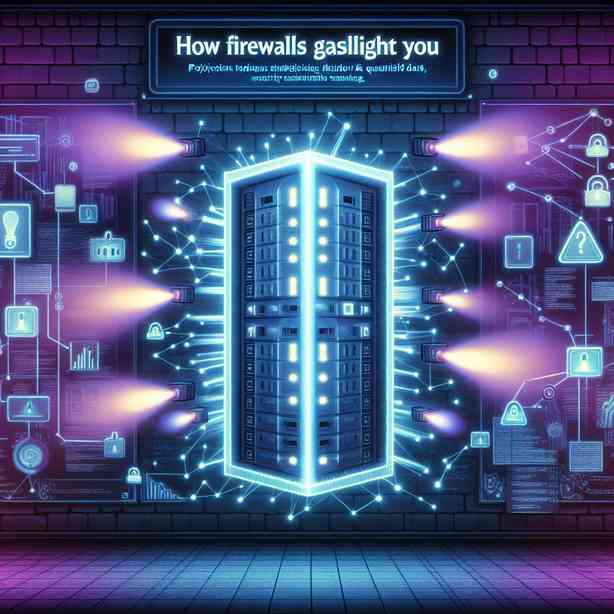
Firewalls play a crucial role in modern cybersecurity, acting as gatekeepers for networks by monitoring and controlling incoming and outgoing traffic. However, the term “gaslighting” might feel out of place in this context. Gaslighting typically refers to a psychological manipulation where individuals are made to question their reality or perceptions. When analyzing the ways in which firewalls operate, it’s vital to understand the dynamics at play, including how misconfiguration or misunderstanding can lead users to doubt their own assessments of security.
At first glance, firewalls embody a straightforward concept: they filter data packets based on predefined security rules. This function aims to prevent unauthorized access to or from a private network. However, the complexity of firewall configurations, coupled with the myriad of threats in the digital landscape, can lead individuals to misinterpret the effectiveness of their security measures. Here, we delve into how this confusion can emerge, and why it’s essential to approach firewalls with a clear understanding.
One of the most common points of misunderstanding arises from a lack of visibility into firewall operations. Many users rely on their firewalls to operate seamlessly, trusting that the configured rules will adequately protect their networks. Yet, periodic blind spots can exist, particularly when updates or changes in network architecture are made. A case in point involves new applications that might not be adequately assessed for security implications before being allowed through the firewall. When problems arise, users may find themselves questioning the efficiency of their firewall without recognizing that the issue may stem from user configuration rather than the firewall’s inherent capabilities.
Moreover, the notion of “false positives” further complicates perceptions of firewalls. A firewall may block legitimate traffic based on its rules, leading users to experience service disruptions or accessibility issues. In these instances, individuals might begin to mistrust their firewall’s judgment, feeling as though it is incorrectly interpreting legitimate threats. This is where the gaslighting metaphor becomes more evident. Users may question their previous decisions regarding network access or begin to doubt their own understanding of what constitutes normal behavior for applications and users alike.
Another critical factor that contributes to this dynamic is the evolving nature of cybersecurity threats. Cyberattacks become increasingly sophisticated, with hackers frequently developing new methods that bypass conventional firewall protections. As users become aware of high-profile breaches, they may feel that their firewall offers inadequate protection. This perception can lead to a sense of paranoia and mistrust toward their security solutions, fostering the belief that they’re fundamentally at risk. In this scenario, the user might ultimately feel responsible for any lapses in security, thereby shifting the blame from the firewall technology, which may be diligently performing its duties without full comprehension from the user.
User education is paramount in this realm. Many users do not fully grasp the nuances of their firewall configurations, leading to misinterpretations about the nature of their safety and security. Firewalls come equipped with advanced features like intrusion detection and prevention systems (IDPS), yet these features require a level of understanding and monitoring to function optimally. Users often overlook the importance of regularly reviewing logs and alerts that a firewall generates, leading to missed opportunities for enhanced security posture management. When users avoid examining these logs, they essentially ignore critical information that would help them understand their security landscape better.
Moreover, vendors and service providers sometimes engage in complex jargon that further obscures the understanding of firewall technology for the average user. Product descriptions filled with technical terms can create a barrier that leads users to feel incompetent or confused about their systems. This feeling mirrors the psychological aspects of gaslighting, where someone questions their reality upon being inundated with complex information that they cannot fully comprehend. Instead of seeking clarity, they may retreat or ignore potential security issues, inadvertently putting themselves at risk.
Another aspect of firewalls that can lead to confusion is the implementation of multiple security solutions. Many organizations employ a multi-layered security approach, using firewalls in conjunction with antivirus programs, cybersecurity training, and more. While this system enhances protection, it can lead to mixed signals about the overall security status of a network. Discrepancies in threat detection across various programs may further complicate users’ perceptions, prompting them to doubt their encryption or security measures as a whole. When alerts vary in severity or sometimes provide contradictory information, users may feel overwhelmed and unsure about the real risks they face.
In certain contexts, advanced firewalls utilize machine learning and artificial intelligence to optimize performance and improve threat detection. While these enhancements offer great advantages, they also contribute to a lack of transparency. Users might struggle to understand how these systems work, leading to further doubt regarding their effectiveness. Without adequate comprehension, users may feel like passive bystanders in their cybersecurity efforts, leading them to question the value of the technology designed to protect them.
As we strive to grasp the intricate interplay of firewalls and user perception, it’s essential to engage in ongoing education and training surrounding firewall operations and cybersecurity best practices. Organizations must prioritize not just the installation of security measures like firewalls, but also the education of their teams to properly interface and manage those technologies. A more informed user base can actively participate in decisions affecting their cybersecurity posture and can advocate for more transparent solutions from vendors when they feel lost in a sea of technical jargon.
In conclusion, while the operations of firewalls are rooted in technology, the perceptions surrounding them can become clouded by misunderstanding and miscommunication. By exploring how firewalls may inadvertently gaslight users through information asymmetry, misconceptions, and the complexities of digital security, we open a critical dialogue about clear communication, user education, and ongoing vigilance in cybersecurity practices. As we navigate the future of cybersecurity, a collaborative approach focused on education, clear policies, and transparent dialogue can bridge the gap between technology and user understanding, enhancing both security and confidence in our digital environments.


